Sumerians 4000 to 2000 BC

Figure 1. Mount Ararat, on which, according to the book of Genesis, Noah's Ark came to rest after the Flood, appears also in Sumerian tradition. It is probably more correctly vocalized as Urartu, the name of a kingdom that existed to the south of the mountain during the earlier part of the 1st millennium BC. The armies of this kingdom pressed long and hard on parts of the northern frontiers of Assyria.
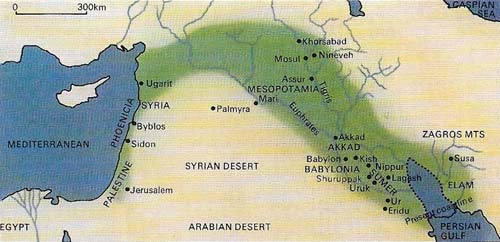
Figure 2. Most of the Fertile Crescent was made up of the Syrian and lower reaches of the Euphrates and Tigris rivers. In the northern parts of this region there was some rainfall and natural fertility, and in the plains of Sumer and Akkad in the southeast, crops wee encouraged by the silt of the rivers and by elaborate irrigation works. The need for these was recognized early by the area's growing civilizations.
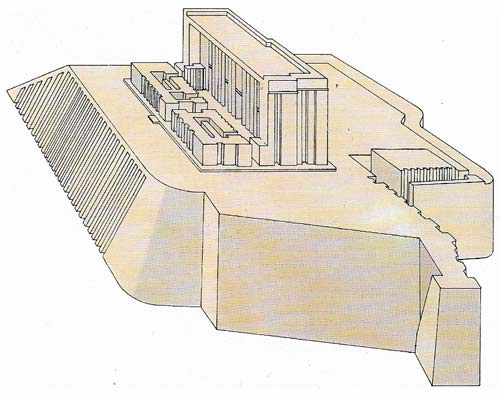
Figure 3. Temple architecture dating from about the end of the fourth millennium is best represented by the White Temple at Uruk, the latest surviving shrine of an irregular mound that was probably an ancestor of the later, more regular ziggurats. The White Temple, approached by three ramps, was built of sun-dried bricks, whitewashed and buttressed, with an altar inside; the building's corners faced points of the compass. A gurat, a many-staged temple mount, may have been an attempt to bridge the gulf between man and the gods. It was strongly felt that man should offer residence to a deity, and the erection of a temple-tower may have bolstered belief in contact with such superhuman powers.
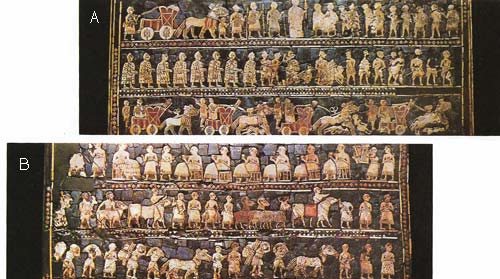
Figure 4. The Royal Standard, dating from about 2600 BC, was found in one of the greatest tombs at Ur. It was apparently carried by an attendant wearing a peculiar bead headdress. It shows fully manned four-wheeled chariots, perhaps referring to victory (A), with domestic scenes on the reverse (B). If it was a "standard" it was very small – 47 centimeters by 20 centimeters (18.5 inches by 7.5 inches) for a public display of royal wealth and success.
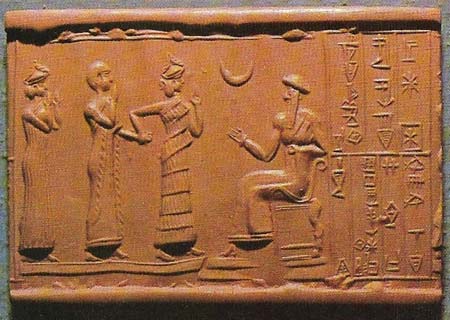
Figure 5. Ur-Nammu (r. c. 2113–c. 2096 BC), King of Ur, to whom this Sumerian seal was dedicated, may not have been a great warrior. But he did publish certain laws dealing, among other things, with sexual offences and wrongs committed in connection with the lands of others.
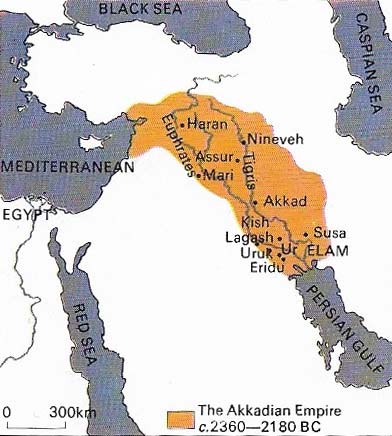
Figure 6. The world's first great empire, under Sargon of Akkad, extended so far that rebellion was almost inevitable, and this evidently occurred even before his death.
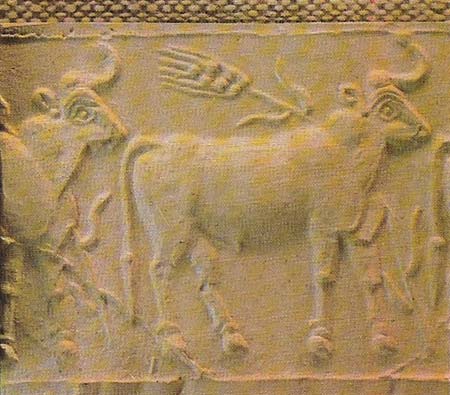
Figure 7. The Mesopotamian harvest was won only after a long struggle against fierce heat and lack of rainfall. Fertility, celebrated on this seal, took on a central religious significance and the actions of nature were believed to be ruled by gods.
The partial excavation of the city of Eridu, about 19 kilometers (12 miles) southwest of "Ur of the Chaldees", the biblical home of Abraham, has produced the earliest settlements so far discovered in Babylonia, and has vindicated the Sumerians' tradition of its antiquity – they thought of it as the first of the five cities that existed before the Flood. Subsequent pre-dynastic periods of settlement, spanning more than the 4th millennium BC, are named, after the relevant sites, Ubaid, Uruk, and Jamdat Nasr.
The earliest dwellings at Eridu apparently consisted partly of reed huts and partly of mud-brick houses. The following pre-dynastic periods progressed successively through painted pottery, fishing-boats and hunting-slings, flint-headed hoes and hard-baked sickles, writing and the potter's wheel, plough and chariot, sculpture in the round, and vessels of silver, copper and lead.
Writing appeared in the Uruk period, a little before 3000 BC; whether the Sumerians brought it with them, or were already there (haying possibly come from Khuzistan, at the foot of the Zagros), is not certain; but there seems no doubt that they invented the art.
The list of Sumerian kings includes a number of monarchs before the Flood, although their position in the archeological framework and their history are unknown. Whether the Flood of Sumerian and Hebrew tradition is represented by the barren strata of silt found at Ur, Kish, and Shuruppak is far from certain. One Ziusudra of Shuruppak, whom we are told survived the Flood, is famous from the Epic of Gilgamesh as the man who preserved the seed of living things; but it was at Kish that "kingship was restored to earth" after the flood.
The First Dynasty of Ur
Little else is known of these kings and leadership passed after a struggle to the famous Gilgamesh of Uruk, and from his successors there to the First Dynasty of Ur. The names of some verified monarchs belong to this period, as does probably the splendid Royal Cemetery. Of two vaults at the bottom of a deep shaft, one (partly plundered) presumably contained the king's remains, and the other those of Queen Shub-ad (or Pu-abi) on a bed, magnificently adorned and accompanied by female attendants.
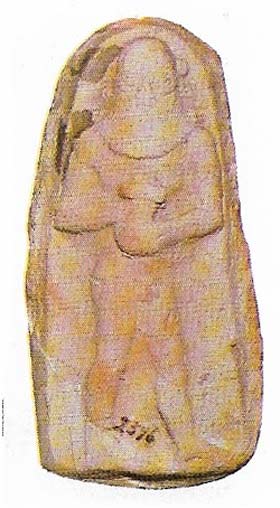 |
| King Gilgamesh of Uruk had more legends told about him than any other hero of Babylonian history. The surviving Assyrian Epic of Gilgamesh was based on a much larger body of legend in Sumerian. This was so muddled that the king's career is quite unclear, although some of the stories may have been based on fact. He probably repaired a sanctuary at Nippur, and almost certainly built the city wall of Uruk. |
Priceless treasures survived in these and the other major graves: golden harps, bull-headed lyres, a golden dagger with lattice sheath, gold and silver florally decorated combs, golden bowls, huge boat-shaped earrings, thousands of beads in gold, silver and cornelian, and much more; as well as the Royal Standard of Ur showing scenes of war and peace in shell and lapis lazuli.
Little reliable information survives about the history of the period following the First Dynasty of Ur, except at Lagash, where the royal line was inaugurated by Ur-Nanshe, whose power is attested by buildings, works of art (some archaic and crude), and inscriptions, including references to cargoes of timber arriving from the Persian Gulf, and giving the impression of inexperience in the use of writing. His grandson Eannatum rose to a supreme position in Sumer and defeated Mari, on the Euphrates, and Subur, perhaps in the north; the supremacy of Lagash was confirmed by his nephew Entemena.
The history of the rest of the Early Dynastic period in Lagash and indeed in the whole of Sumer is largely ill-attested, but Urukagina (reigned c. 2378–c. 2371 BC) with a surprising political maturity instituted social reforms – some apparently intended to lighten burdens imposed on the population by governors and priests. He fell to Lugalzag-gisi of Umma, who in turn fell, after a substantial and evidently successful reign, to the great Sargon of Akkad (reigned c. 2371–c. 2316 BC).
Sargon the Great, King of Akkad
Sargon rose from obscurity to overthrow Lugalzaggisi, and to subdue the rest of Sumer, Syria, perhaps part of Asia Minor, and much, apparently, of the mountain area of southwestern Iran. Revolt followed, but his grandson Naram-Sin ruled gloriously for 37 years. Sargon's line fell in c. 2230 BC to the Gutian tribes from the north or northeast, whose sovereignty left little mark on history and few monuments (although Lagash emerged to a period of great prosperity about that time under Ur-Baba and Gudea), and who were expelled by Utu-khegal of Uruk; his deputy at Ur, Ur-Nammu (6), seems to have overthrown him, and so founded the dynasty of Ur.
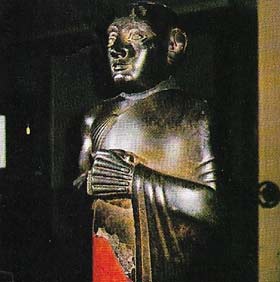 |
| Gudea of Lagash, shown here, was the son-in-law of Ur-Baba, who brought to his city enough wealth to undertake extensive public works. He also patronized a school of sculptors who soon began to produce the finest masterpieces in hardstone. Udea himself left inscriptions describing the religious observances and daily life of his time. He also enumerated the timbers and ornamental stones used in rebuilding the house of his god Ningirsu, on which he spent nearly all his wealth. |
The Third Dynasty of Ur
Ur-Nammu did not take the title "King of the Four Regions" – perhaps acknowledging his relatively limited authority – but assumed the new title "King of Sumer and Akkad". His 18-year reign was a time of considerable wealth and power, as shown by his many great building works, including the restoration of direct communication by water with the Gulf. His successor Shulgi (reigned c. 2095–c. 2048 BC) extended his territories in the northeast and east, dealing among others with the Gutians and the Hurrians; he also made his literary mark in his letters and royal hymns, and claims to have been a master performer on eight musical instruments. His second successor Shu-Sin (reigned c. 2038–c. 2030 BC) had to face the threat of western incursion; Ibbi-Sin (reigned c. 2029–c. 2006 BC), who claimed victory over these Amorites (under Ishbi-Errs of Mari), later saw his city fall to the Elamites.
